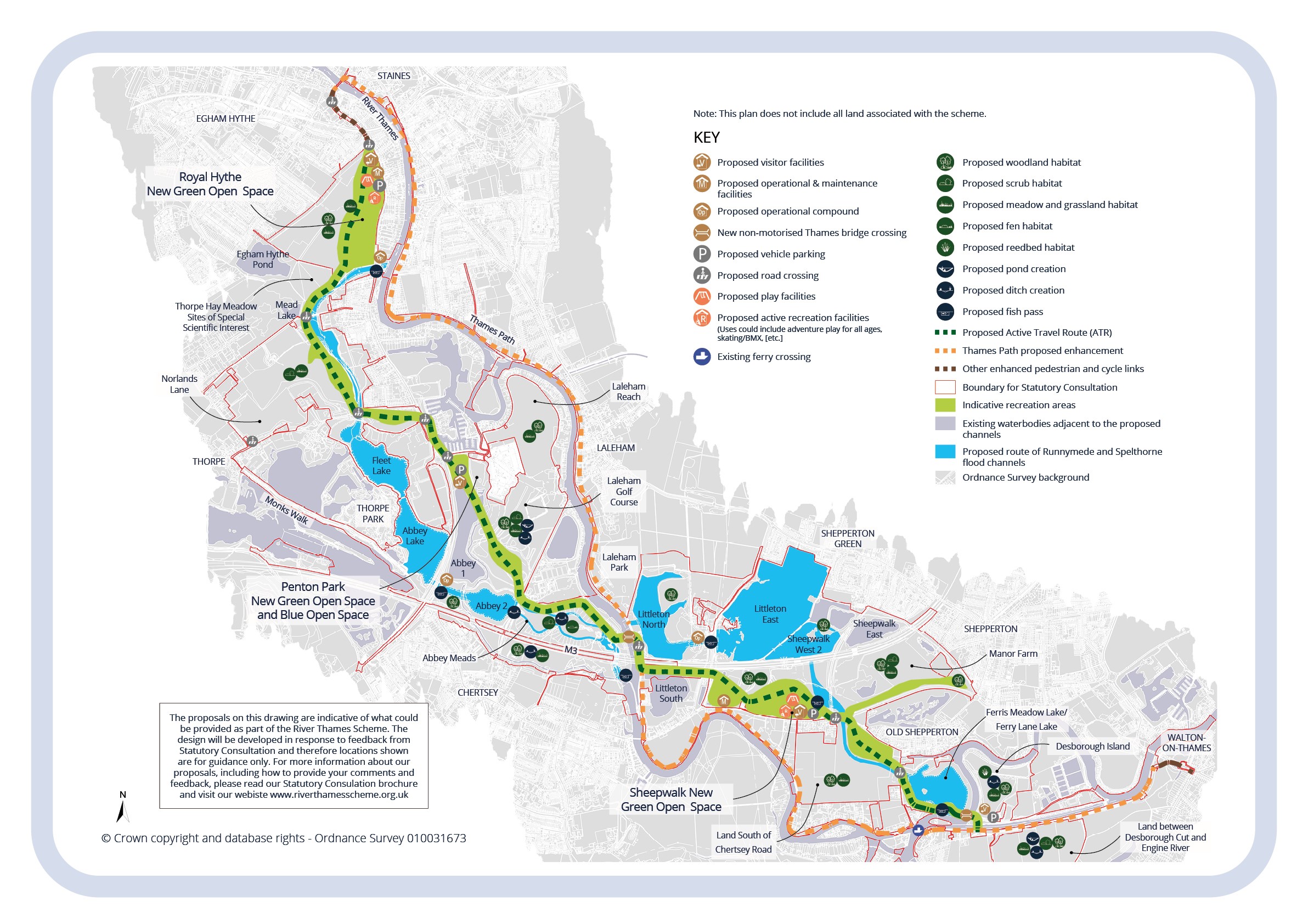Active travel
Published: 24 June 2024
The River Thames Scheme (RTS) is not only designed to reduce the risk of flooding but also to make the area a more attractive place to live and visit by providing extensive active travel routes.
The active travel elements of the design proposals are intended to promote healthier lifestyles, environmental sustainability, and stronger community links.
The green development will combine natural landscapes with travel routes, offering safe paths for pedestrians, cyclists, and those wheeled mobility users. These will be accessible and enjoyable for all – to encourage healthier and sustainable forms of transport. There will be better links between various parts of Surrey and surrounding regions, thus making travel easier and quicker, reducing traffic congestion, and environmental impacts arising from traffic.
The proposals include:
Walking and cycling paths
The scheme will establish new and improved footpaths and cycle routes along the River Thames. The active travel networks will run outside, along and across the channel corridor and through the newly created green open spaces making it easier to move between communities and access local amenities.
Safety is paramount and the scheme will create segregate cyclists and pedestrians and look to ensure accessibility for wheeled mobility users. The integration of the active travel routes aims to reduce the need for cars, making using these new active travel networks an attractive alternative for daily commuting and leisure activities.
Creation of natural landscape
The process for the design work for the proposed Landscape and Green Infrastructure began with four conceptual landscape themes, to ensure the scheme achieves its goals.
Visually connected green spaces
Open spaces with significantly raised landforms to provide new visual connections across the breadth of the RTS.
Active recreation, green spaces
Open spaces for intensive active recreation and sports, seeking to attract visitors from a wide area.
Active travel 'snaking rampart'
A commuter and recreation route for cyclists, pedestrians and other wheeled mobility users, linking communities and the new green open spaces.
Enhanced ecological value
Ecological benefits for wildlife and habitats with relatively restricted access opportunities.
Connecting communities
A key feature of the scheme is the construction of new footbridges over the River Thames. These footbridges will provide crucial links between communities on either side of the river, enhancing accessibility and making it easier for people to travel by foot or bike. The footbridges are designed to be visually appealing and integrated into the natural landscape, ensuring they complement the surrounding environment while providing practical benefits.
Landscape and Green Infrastructure Design
The proposals on this drawing are indicative of what could be provided as part of the River Thames Scheme. The design will be developed in response to the feedback received during Statutory Consultation and therefore locations shown are for guidance only.

Map overview of the scheme
View full-size image (PDF)
Highlighting community support
Following an options appraisal process which tested these themes against factors such as planning policies, flood risk, buildability, affordability, carbon generation/mitigation and biodiversity/ecology and workshops with Local Planning Authorities and Special Interest Groups. The design proposal was shared at Statutory Consultation early in 2024.
Statutory Consultation revealed significant support for the green proposals presented for the scheme, with over 80% of respondents expressing a preference said they 'strongly agreed' or 'agreed' with the proposals to provide an active travel route, while more than 80% of respondents expressing a preference said they 'strongly agreed' or 'agreed' with the proposals to provide new habitats as part of the scheme.
Benefits of the active travel route
The RTS is an integrated scheme, and its benefits range from physical health to the environment. The active travel routes will improve health by encouraging physical activity and environmentally, it looks to cut carbon emissions and improve air quality by reducing the need for car journeys. This shift toward greener travel choices is an essential step in nurturing a more sustainable environment.
Socially, the scheme will enhance community interaction through creating accessible and attractive travel routes encouraging social interaction. Public spaces along the scheme routes will be designed in ways that foster social interaction, increasing the quality of life for both the residents and visitors. Economically, the improved travel infrastructure is likely to attract more visitors and residents, boosting local economies. Increased footfall to local businesses and recreational areas is likely to lead to economic growth and job creation for the wider community.
Document history
Published: 24 June 2024
Updated: 09 July 2025
